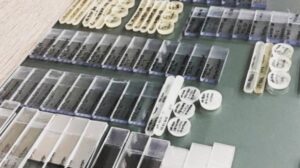Selecting the right adhesive is vital for the success and durability of any project. Two popular options are UV adhesives and anaerobic adhesives, each with unique properties and applications. In this blog, we will compare these two types of adhesives to help you decide which one suits your needs best.
Understanding UV Adhesive
UV adhesive, also known as UV-cured adhesive, cures and hardens upon exposure to ultraviolet light. This adhesive is widely used in industries such as electronics, medical devices, and glass bonding because of its fast curing time and strong bonds.
Understanding Anaerobic Adhesive
Anaerobic adhesive cures in the absence of air (oxygen) and in the presence of metal ions. This makes it ideal for applications involving metal parts, such as threadlocking, retaining, gasketing, and sealing. It is commonly used in the automotive and industrial sectors.
Key Differences Between UV Adhesive and Anaerobic Adhesive
1. Curing Process
- UV Adhesive: Requires exposure to UV light to initiate curing. The process is quick, usually taking only seconds to a few minutes.
- Anaerobic Adhesive: Cures in the absence of air and in the presence of metal ions. It generally takes longer to cure compared to UV adhesives, ranging from minutes to hours.
2. Bond Strength and Durability
- UV Adhesive: Known for its strong, durable bonds, especially with non-porous materials like glass, metal, and certain plastics. It is also resistant to temperature fluctuations and environmental factors.
- Anaerobic Adhesive: Provides robust bonding for metal parts, ensuring a secure hold even under mechanical stress. It is resistant to chemicals, heat, and vibration.
3. Applications
- UV Adhesive: Ideal for applications requiring precision and clarity, such as electronics, medical devices, and glass bonding. It is also used in some woodworking and automotive repairs.
- Anaerobic Adhesive: Best suited for mechanical assemblies, including threadlocking, retaining, gasketing, and sealing metal parts. It is widely used in automotive and industrial applications.
4. Environmental Impact
- UV Adhesive: Generally more environmentally friendly, as it does not release volatile organic compounds (VOCs) during curing. This makes it a safer choice for both workers and the environment.
- Anaerobic Adhesive: May release small amounts of VOCs, but is typically considered safe with proper handling and ventilation.
5. Storage and Shelf Life
- UV Adhesive: Usually has a longer shelf life and can be stored at room temperature without special requirements.
- Anaerobic Adhesive: Requires airtight storage to prevent premature curing. Its shelf life can be shorter compared to UV adhesives if not stored properly.
Choosing the Right Adhesive for Your Project
When deciding between UV adhesive and anaerobic adhesive, consider the following factors:
- Curing Time: If you need a fast-curing adhesive for quick production, UV adhesive is the better choice.
- Material Compatibility: For non-porous materials like glass and certain plastics, UV adhesive is ideal. For metal parts, especially in mechanical assemblies, anaerobic adhesive is the preferred option.
- Application Precision: UV adhesives are perfect for applications requiring high precision and clarity.
- Environmental Concerns: UV adhesives are generally more environmentally friendly, releasing fewer VOCs.
- Storage Requirements: Consider the storage conditions and shelf life of the adhesive. UV adhesives typically require less stringent storage conditions compared to anaerobic adhesives.
Conclusion
Both UV adhesives and anaerobic adhesives offer unique advantages and are suited for different applications. By understanding their differences and evaluating your project’s specific needs, you can make an informed decision. Whether you prioritize fast curing, bond strength, material compatibility, or environmental impact, there’s an adhesive solution that meets your requirements.
For more information on adhesives and their applications, feel free to reach out to our team of experts. We’re here to help you find the perfect adhesive for your next project.
